Themed collection Hard X-rays and the Frontiers of Materials Chemistry

High energy X-rays and the frontiers of materials chemistry
This themed issue presents applications of high energy X-rays to fundamental and industrially applicable materials chemistry, with an emphasis on in situ and time-resolved studies in demanding sample environments.

Phys. Chem. Chem. Phys., 2013,15, 8458-8460
https://doi.org/10.1039/C3CP90046K
Mapping spatially inhomogeneous electrochemical reactions in battery electrodes using high energy X-rays
Spatially-resolved PDF studies indicate that electrochemical reactions proceed non-uniformly through a Li-ion battery electrode, being most advanced near the electrode–electrolyte interface.

Phys. Chem. Chem. Phys., 2013,15, 8466-8469
https://doi.org/10.1039/C3CP50590A
Operando XAFS study of catalytic NO reduction over Cu/CeO2: the effect of copper–ceria interaction under periodic operation
Synchronization of Cu and Ce valence change in Cu/CeO2 under periodic operation can improve the catalytic NO reduction.
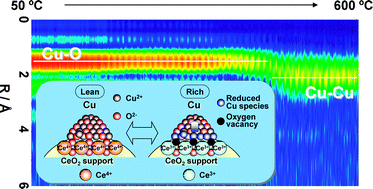
Phys. Chem. Chem. Phys., 2013,15, 8461-8465
https://doi.org/10.1039/C3CP44316G
In situ reduction study of cobalt model Fischer–Tropsch synthesis catalysts
Fischer–Tropsch (FT) synthesis is an important process to manufacture hydrocarbons and oxygenated hydrocarbons from mixtures of carbon monoxide and hydrogen (syngas).
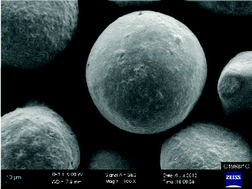
Phys. Chem. Chem. Phys., 2013,15, 11640-11645
https://doi.org/10.1039/C3CP50274K
Lone-pair distribution and plumbite network formation in high lead silicate glass, 80PbO·20SiO2
The structure of a lead silicate glass, 80PbO·20SiO2, with extremely high lead content is studied by high energy X-ray and neutron diffraction, and empirical structural modelling, in order to reveal details of the plumbite based glass network and electron lone-pair distribution.

Phys. Chem. Chem. Phys., 2013,15, 8506-8519
https://doi.org/10.1039/C3CP51348C
Elucidation of structure and nature of the PdO–Pd transformation using in situ PDF and XAS techniques
The reversible PdO → Pd0 transformation in a Pd/Al2O3 catalyst is investigated using in situ PDF and Pd K-edge XAS techniques. These studies reveal the presence of residual PdO, of the order ca. 30%, at high temperatures.
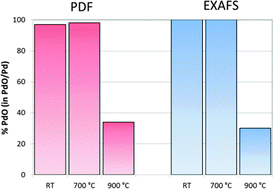
Phys. Chem. Chem. Phys., 2013,15, 8555-8565
https://doi.org/10.1039/C3CP50600B
Synchrotron high energy X-ray methods coupled to phase sensitive analysis to characterize aging of solid catalysts with enhanced sensitivity
X-ray absorption spectroscopy and X-ray diffraction are combined with a modulated excitation approach to enhance their sensitivity towards subtle structural changes in working catalysts.

Phys. Chem. Chem. Phys., 2013,15, 8629-8639
https://doi.org/10.1039/C3CP44638G
K-edge XANES investigation of octakis(DMSO)lanthanoid(III) complexes in DMSO solution and solid iodides
K-edge XANES spectra at very high energy have been found to provide accurate structural information on the coordination geometry of lanthanoid ions.
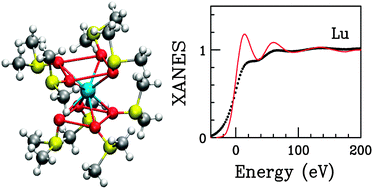
Phys. Chem. Chem. Phys., 2013,15, 8684-8691
https://doi.org/10.1039/C3CP50842K
Pair distribution function (PDF) analysis of mesoporous α-Fe2O3 and Cr2O3
Advanced manipulation techniques used to study the PDF’s of mesoporous hematite and eskolaite provide insight into long range order breakdown.

Phys. Chem. Chem. Phys., 2013,15, 8583-8588
https://doi.org/10.1039/C3CP44322A
Structural changes in supercooled Al2O3–Y2O3 liquids
Structural changes in liquids between Al2O3 and Y2O3 are investigated as a function of the composition and during supercooling using high energy X-ray diffraction (HEXRD) combined with containerless aerodynamic levitation and many-body molecular dynamics simulation.
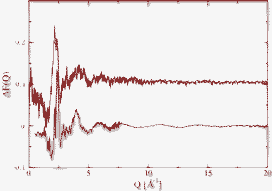
Phys. Chem. Chem. Phys., 2013,15, 8589-8605
https://doi.org/10.1039/C3CP51209F
In situ XRD studies of nanocrystallization of Fe-based metallic glass: a comparative study by reciprocal and direct space methods
The pair distribution function is a reliable tool to determine sizes of ultrafine nanocrystals (below 8 nm) which makes observation of early stages of crystallization possible.

Phys. Chem. Chem. Phys., 2013,15, 8470-8479
https://doi.org/10.1039/C3CP44445G
Unraveling the atomic structure of Ge-rich sulfide glasses
Combination of high-energy X-ray and neutron diffraction reveals the complexity of the short and intermediate range order in GexS1−x glasses, ⅓ ≤ x ≤ 0.47.

Phys. Chem. Chem. Phys., 2013,15, 8487-8494
https://doi.org/10.1039/C3CP50536G
A time resolved high energy X-ray diffraction study of cooling liquid SiO2
Time resolved X-ray measurements on liquid SiO2 show subtle changes in structure around the glass transition and reported density maximum.
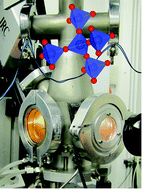
Phys. Chem. Chem. Phys., 2013,15, 8566-8572
https://doi.org/10.1039/C3CP44347G
A XAS study of the luminescent Eu centers in thiosilicate phosphors
In this article the photoluminescence of europium doped thiosilicate phosphors is correlated to the incorporation and valence state of the dopant ions, as studied by X-ray absorption spectroscopy.
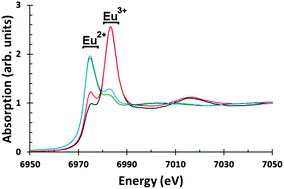
Phys. Chem. Chem. Phys., 2013,15, 8678-8683
https://doi.org/10.1039/C3CP44334E
The fast Z-scan method for studying working catalytic reactors with high energy X-ray diffraction : ZSM-5 in the methanol to gasoline process
High energy, time and space resolved X-ray diffraction reveals different behaviour in different parts of a methanol to gasoline reactor.

Phys. Chem. Chem. Phys., 2013,15, 8662-8671
https://doi.org/10.1039/C3CP44343D
Influence of the Ce–Zr promoter on Pd behaviour under dynamic CO/NO cycling conditions: a structural and chemical approach
The behaviour of the Pd phase in three way catalysts (TWCs) having a Ce–Zr oxide as a promoter component has been examined under CO/NO cycling conditions.
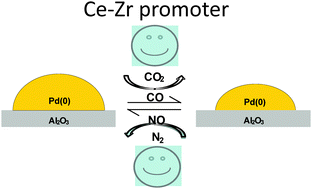
Phys. Chem. Chem. Phys., 2013,15, 8640-8647
https://doi.org/10.1039/C3CP44293D
Confirmation of disordered structure of ultrasmall CdSe nanoparticles from X-ray atomic pair distribution function analysis
For ultrasmall CdSe nanoparticles smaller than 2 nm, the average structure is significantly modified from that of larger particles and the bulk.
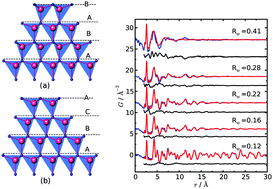
Phys. Chem. Chem. Phys., 2013,15, 8480-8486
https://doi.org/10.1039/C3CP00111C
Effects of rare-earth co-doping on the local structure of rare-earth phosphate glasses using high and low energy X-ray diffraction
Rare-earth co-doping in inorganic materials has a long-held tradition of facilitating highly desirable optoelectronic properties for their application to the laser industry.

Phys. Chem. Chem. Phys., 2013,15, 8529-8543
https://doi.org/10.1039/C3CP44298E
In situ X-ray pair distribution function analysis of geopolymer gel nanostructure formation kinetics
The reaction kinetics of low-CO2 cements (geopolymers) are investigated using in situ X-ray pair distribution function analysis, revealing important mechanistic details regarding the role of free silica in the activator.

Phys. Chem. Chem. Phys., 2013,15, 8573-8582
https://doi.org/10.1039/C3CP44342F
Adsorption of N/S heterocycles in the flexible metal–organic framework MIL-53(FeIII) studied by in situ energy dispersive X-ray diffraction
The ‘breathing’ metal organic framework MIL-53 effectively adsorbs sulfur-containing heterocycles with an expansion of its structure; the selectivity of uptake of guests has been monitored using time-resolved energy-dispersive X-ray diffraction.
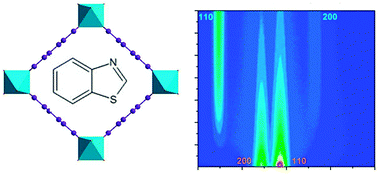
Phys. Chem. Chem. Phys., 2013,15, 8606-8615
https://doi.org/10.1039/C3CP44349C
Mechanisms behind sulfur promoted oxidation of methane
The promoting effect of SO2 on the activity for methane oxidation over platinum supported on silica, alumina and ceria has been studied using a flow-reactor, in situ infrared spectroscopy and in situ high-energy X-ray diffraction experiments.

Phys. Chem. Chem. Phys., 2013,15, 8648-8661
https://doi.org/10.1039/C3CP44289F
A kinetic and mechanistic study into the formation of the Cu–Cr layered double hydroxide
The formation mechanism and kinetics of the Cu–Cr layered double hydroxide have been explored using in situ synchrotron X-ray diffraction and quenching studies.
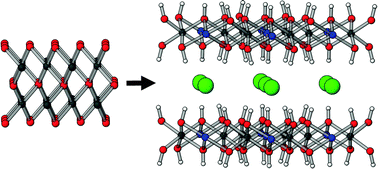
Phys. Chem. Chem. Phys., 2013,15, 8616-8628
https://doi.org/10.1039/C3CP44339F
In situ pair distribution function study on lanthanum doped ceria
PDF study on doped ceria under operating conditions revealed that the dopant retains its local environment as in its pure oxide.

Phys. Chem. Chem. Phys., 2013,15, 8495-8505
https://doi.org/10.1039/C3CP44300K
A variable temperature synchrotron X-ray diffraction study of the ferroelastic double perovskite Ba2GdMoO6
Ferroelasticity in Ba2GdMoO6 is manifest in synchrotron X-ray diffraction patterns as diffuse scattering between diffraction peaks below 220 K ((b) and (c)).

Phys. Chem. Chem. Phys., 2013,15, 8672-8677
https://doi.org/10.1039/C2CP43732E
Atomic pair distribution functions analysis of disordered low-Z materials
Results of high-energy X-ray diffraction experiments coupled to atomic pair distribution function analysis of disordered low-Z materials are presented.

Phys. Chem. Chem. Phys., 2013,15, 8544-8554
https://doi.org/10.1039/C2CP43378H
Structure of Nb2O5–NaPO3 glasses by X-ray and neutron diffraction
The NbO6 octahedron is distorted with three Nb–O distances for glasses of Nb2O5 content ≤0.2 and it changes above that.
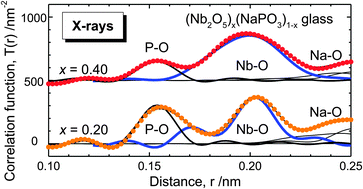
Phys. Chem. Chem. Phys., 2013,15, 8520-8528
https://doi.org/10.1039/C2CP42772A
About this collection
This themed issue, guest edited by Mark Newton, presents applications of high energy X-rays to fundamental and industrially applicable materials chemistry, with an emphasis on in situ and time-resolved studies in demanding sample environments